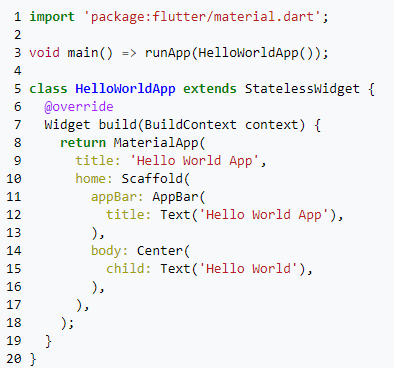What is Flutter?
 | |
| Original author(s) | |
|---|---|
| Developer(s) | Google and community |
| Initial release | Alpha (v0.0.6) / May 2017 |
| Stable release | v1.17.1 / May 14, 2020 |
| Preview release | 1.18.0-10.0.pre / May 5, 2020 |
| Written in | C, C++, Dart |
| Platform | Android, iOS, Google Fuchsia, Web platform, Windows, macOS and Linux |
| Type | Application framework |
| License | New BSD License |
| Website | flutter |
Flutter is an open-source UI software development kit created by Google. It is used to develop applications for Android, iOS, Windows, Mac, Linux, Google Fuchsia and the web.
The first version of Flutter was known as codename "Sky" and ran on the Android operating system. It was unveiled at the 2015 Dart developer summit, with the stated intent of being able to render consistently at 120 frames per second.During the keynote of Google Developer Days in Shanghai, Google announced Flutter Release Preview 2 which is the last big release before Flutter 1.0. On December 4, 2018, Flutter 1.0 was released at the Flutter Live event, denoting the first "stable" version of the Framework. On December 11, 2019, Flutter 1.12 was released at the Flutter Interactive event.
Framework architecture
The major components of Flutter include:
- Dart platform
- Flutter engine
- Foundation library
- Design-specific widgets
Dart platform
Flutter apps are written in the Dart language and make use of many of the language's more advanced features.
On Windows, macOS and Linux via the semi-official Flutter Desktop Embedding project, Flutter runs in the Dart virtual machine which features a just-in-time execution engine. While writing and debugging an app, Flutter uses Just In Time compilation, allowing for "hot reload", with which modifications to source files can be injected into a running application. Flutter extends this with support for stateful hot reload, where in most cases changes to source code can be reflected immediately in the running app without requiring a restart or any loss of state. This feature as implemented in Flutter has received widespread praise.
Release versions of Flutter apps are compiled with ahead-of-time (AOT) compilation on both Android and iOS, making Flutter's high performance on mobile devices possible.
Flutter engine
Flutter's engine, written primarily in C++, provides low-level rendering support using Google's Skia graphics library. Additionally, it interfaces with platform-specific SDKs such as those provided by Android and iOS.[8] The Flutter Engine is a portable runtime for hosting Flutter applications. It implements Flutter's core libraries, including animation and graphics, file and network I/O, accessibility support, plugin architecture, and a Dart runtime and compile toolchain. Most developers will interact with Flutter via the Flutter Framework, which provides a modern, reactive framework, and a rich set of platform, layout and foundation widgets.
Foundation library
The Foundation library, written in Dart, provides basic classes and functions which are used to construct applications using Flutter, such as APIs to communicate with the engine.
Design-specific widgets
The Flutter framework contains two sets of widgets which conform to specific design languages. Material Design widgets implement Google's design language of the same name, and Cupertino widgets implement Apple's iOS Human interface guidelines.
Hello World example :-
A Hello, World program in Flutter looks like this:





0 Comments